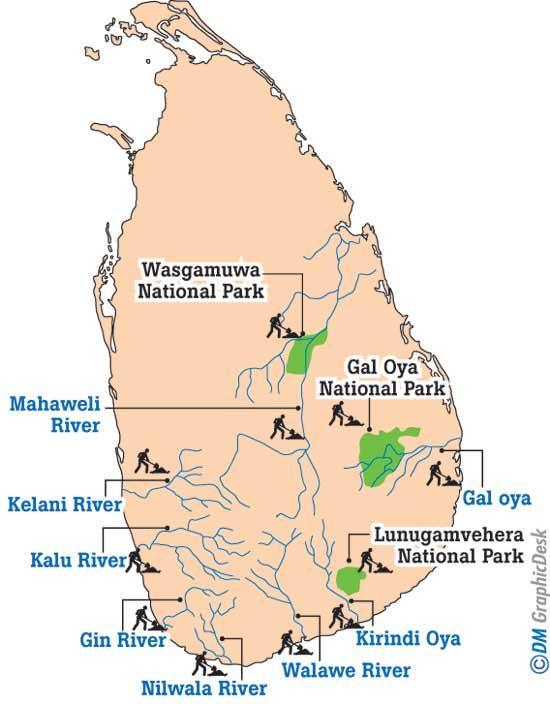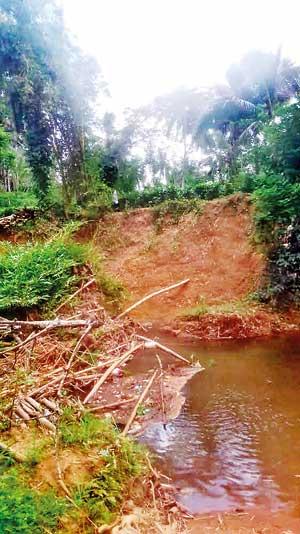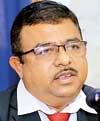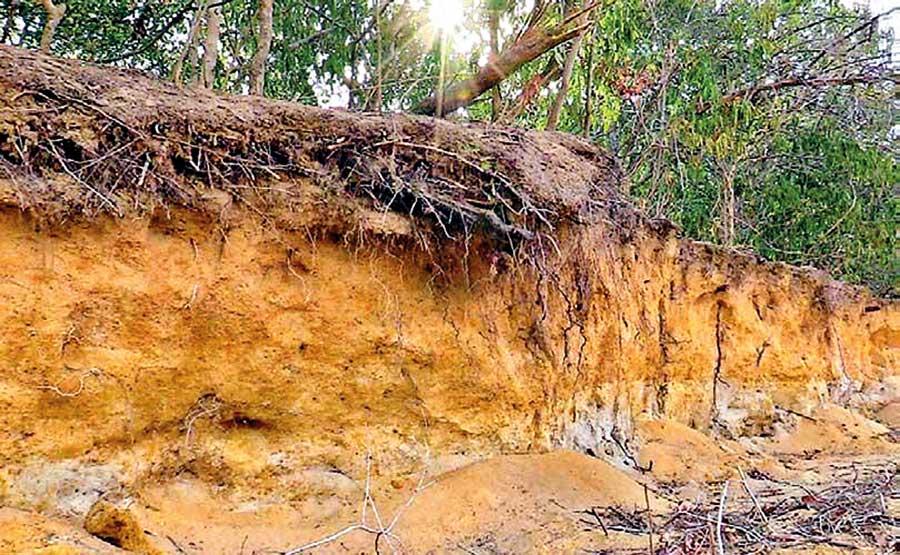Eroded banks along a river in Kallaru
- Over the past month, there had been a startling increase in the number of incidents related to sand mining
- it had been quite evident that most sand mining activities take the form of river sand mining
River sand mining has been an illegal money-spinning business filling the pockets of politicians and many other stakeholders in related industries. However, with the new Government’s decision to suspend the licence system for transporting sand, soil, clay and granite, the number of incidents, mainly illegal, has risen. The subsequent decision changes the process of  issuing quarry permits and the Circular No 173/12/2019 issued by the Geological Survey and Mines Bureau (GSMB) on December 31, 2019, changes the procedures set out in the National Environmental Act No 47. Of 1980 as amended, Urban Development Authority Act No 41 of 1988 as amended, and the Mines and Minerals Act No 33 of 1992 as amended.
issuing quarry permits and the Circular No 173/12/2019 issued by the Geological Survey and Mines Bureau (GSMB) on December 31, 2019, changes the procedures set out in the National Environmental Act No 47. Of 1980 as amended, Urban Development Authority Act No 41 of 1988 as amended, and the Mines and Minerals Act No 33 of 1992 as amended.
With that in mind the Daily Mirror takes a look at how the permit controlled the process, environmental implications and legal setbacks.
An illegal business gone out of bounds
Over the past month, there had been a startling increase in the number of incidents related to sand mining. In the North, mining activities were reported in all five districts while incidences of such activities have also increased along the banks of Kirindi Oya, Gal Oya, Mahaweli, Walawe, Kelani, Nilwala, Gin and Kalu rivers. Apart from that protected areas such as Lunugamvehera, Wasgamuwa and Gal Oya National Parks have also been exposed to large scale sand mining.
Legitimizing illegalities
Section 28 of the Mines and Minerals Act states that no person shall explore for mine, transport, process, trade in or export any minerals except under the authority of, or otherwise than in

accordance with, a licence issued in that behalf under the provisions of this Act and regulations made thereafter. “Therefore a transport permit is a legal requirement under this section,” opined Attorney-at-Law Jagath Gunawardena. “Unless it’s revoked as an amendment, this order to cancel transport permits is blatantly illegal. The law cannot be superseded in a cabinet decision,” said Gunawardena.
Section 30 subsection C states that the Bureau shall not issue a licence to explore for or mine any minerals upon:
- burial ground or cemetery
- any land within such distance of a railway track, aerodrome, road, thoroughfare, power line or other public work or
- public building,
- any land situated within such distance of a lake, stream or a tank or bund within the meaning of the Crown Lands Ordinance (Chapter 454), as may be prescribed, without the approval of the Minister
- any wild life reservation, nature reserve, forest or park
- any land situated within such distance of a catchment area, foreshore, seabed.
However, it had been quite evident that most sand mining activities take the form of river sand mining as it could be conveniently done, ignoring environmental implications. With the cancellation of a transport permit, anybody could now mine for sand from anywhere in this country as it has legitimised something that is illegal.
 "If they feel that there would be no environmental implications then they can go ahead with issuing the licence. But we do not know how they would estimate the extent of
"If they feel that there would be no environmental implications then they can go ahead with issuing the licence. But we do not know how they would estimate the extent of
harm caused - Siripala Amarasinghe"
Permit as a control
“The permit quantified the mining process since the Geological Survey and Mines Bureau (GSMB) didn’t have the manpower to monitor all places where mining took place,” explained Jayantha Wijesinghe, Convener of Rainforest Protectors Sri Lanka. “It specifically states how many cubes of sand could be mined for a day, month and which routes could be used to transport them. A smaller vehicle could use a smaller road, but since the transport permit has been removed, there’s no control of which routes they’d use. The permit also describes how they should transport the material. Therefore it should be covered and shouldn’t fall off onto the roads. They cannot be transported during school hours and likewise there was a major control. But now, anybody could do it. Therefore more than one million people have the potential to be involved in this illegal business which has become legitimised all of a sudden. Now, anybody who has a tipper or a lorry could reverse their vehicle to a sand mining area and
transport the materials,” he said.
He further said that if the Act is amended and the Central Environmental Authority (CEA) is taken away from the process, nobody would be able to lodge a complaint. “The GSMB has been supporting unsustainable mining activities over the years and excavation work has been continuing with the blessings of the subject minister. But the GSMB is the sole authority that should have regulated mining activities. After all, no amount of planting trees can compensate this ongoing mass excavation process,” he explained.
"Now, anybody who has a tipper or a lorry could reverse their vehicle to a sand mining area and transport the materials"
Environmental implications
“If you take the groundwater table, taking off 5 metres of its top soil layer would result in the groundwater table going down by 5 metres,” he added. “When lands become barren there’s a
 |
| Illegal sand mining activities along the banks of Nilwala River have caused the banks to erode into the river posing a threat to tea estates in Morawaka and surrounding areas |
high tendency for invasive species such as Acacia to grow. Barren lands also add to the temperature. Most areas used for mining purposes are highly biodiverse. I have seen granite mountains bleeding out water as a result of haphazard mining activities. Water sources, catchment and watershed areas shouldn’t be used for mining purposes. Once sand is collected they fill the wetlands and it’s not being monitored anymore. If you visit places such as Thalangama and Diyawannawa areas this is very evident. As a result of mining for silica and clay, these haphazard activities have created pools and manholes deep enough to kill a person if he or she accidentally falls into one,” he stressed.
"The river banks start falling and sediment gets collected from the falling river bank. With the falling river the buffer area gets destroyed. For example, people in the Wewa Ganga area used to walk across the river, but now they are using a boat"
Speaking about river-sand mining, Wijesinghe further said that the river depth increases and water gets muddy. “The river banks start falling and sediment gets collected from the falling river bank. With the falling river the buffer area gets destroyed. For example, people in the Wewa Ganga area used to walk across the river, but now they are using a boat. This is because the river has sunk by 7 feet due to sand mining activities. Eventually they will have to use a bridge to get to the other side of the river. It will then cause flooding. Apart from that, fish lay eggs in sand and by removing sand, it will destroy native populations of fish. People who bathe in these rivers may even drown due to the manholes created by mining activities. Therefore it is extremely hazardous to mankind even though it’s a money-spinning business,” he added.
"Water sources, catchment and watershed areas shouldn’t be used for mining purposes"
 "Therefore anybody can login to this App and check if the transportation of materials is valid. On the other hand we have increased the number of raids - Anura walpola"
"Therefore anybody can login to this App and check if the transportation of materials is valid. On the other hand we have increased the number of raids - Anura walpola"
Measures taken by GSMB
Under the Mines & Minerals Act No. 33 of 1992, the GSMB issues three types of licences, i.e., Exploration, Mining, Trading and Transport. With the cancellation of transport permits, there has been an increase in the number of incidents of sand mining especially in the Northern Province. “As means of controlling it we have asked the mining licence holder to issue a permit to those who are transporting it,” said GSMB Chairman Anura Walpola. “If they are transporting 500 cubes of sand, then they should write it in the permit and hand it over to the person taking the materials because the Army and STF are constantly checking on these vehicles. If they don’t have a permit their licence becomes invalid,” he warned.
He also said that an App has been introduced to register the vehicles transporting sand. “This has been implemented as a pilot project in Kalutara and Kurunegala areas and will be in effect within the next one and a half months. Therefore anybody can login to this App and check if the transportation of materials is valid. On the other hand we have increased the number of raids and patrols to ensure that no illegal sand mining activity is being carried out,” he added.
"After all, no amount of planting trees can compensate this ongoing mass excavation process"
A question of technical expertise
Although the GSMB had been issuing the licences for mining soil, sand and granite the CEA has the technical expertise and is answerable regarding any legal matter. “The way the licence system was suspended was extremely doubtful,” said CEA Chairman Siripala Amarasinghe. “We were not informed about it in the first place. Therefore we were of the stance that we will not be responsible for any damage caused to the environment.
Then the subject minister had asked the GSMB to inform us in writing if they feel that a potential harm could be caused to the environment in any given area of mining. If they feel that there would be no environmental implications then they can go ahead with issuing the licence. But we do not know how they would estimate the extent of harm caused since they don’t have the technical expertise. If somebody lodges a complaint it is done through CEA, but how can we be responsible for something done without our knowledge?” he questioned.
Several attempts to contact subject minister S. M Chandrasena proved futile.

 issuing quarry permits and the Circular No 173/12/2019 issued by the Geological Survey and Mines Bureau (GSMB) on December 31, 2019, changes the procedures set out in the National Environmental Act No 47. Of 1980 as amended, Urban Development Authority Act No 41 of 1988 as amended, and the Mines and Minerals Act No 33 of 1992 as amended.
issuing quarry permits and the Circular No 173/12/2019 issued by the Geological Survey and Mines Bureau (GSMB) on December 31, 2019, changes the procedures set out in the National Environmental Act No 47. Of 1980 as amended, Urban Development Authority Act No 41 of 1988 as amended, and the Mines and Minerals Act No 33 of 1992 as amended.  accordance with, a licence issued in that behalf under the provisions of this Act and regulations made thereafter. “Therefore a transport permit is a legal requirement under this section,” opined Attorney-at-Law Jagath Gunawardena. “Unless it’s revoked as an amendment, this order to cancel transport permits is blatantly illegal. The law cannot be superseded in a cabinet decision,” said Gunawardena.
accordance with, a licence issued in that behalf under the provisions of this Act and regulations made thereafter. “Therefore a transport permit is a legal requirement under this section,” opined Attorney-at-Law Jagath Gunawardena. “Unless it’s revoked as an amendment, this order to cancel transport permits is blatantly illegal. The law cannot be superseded in a cabinet decision,” said Gunawardena. "If they feel that there would be no environmental implications then they can go ahead with issuing the licence. But we do not know how they would estimate the extent of

"Therefore anybody can login to this App and check if the transportation of materials is valid. On the other hand we have increased the number of raids - Anura walpola"